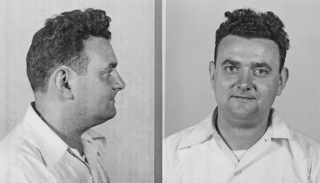The Venona project was a counterintelligence program initiated by the United States Army's Signal Intelligence Service that ran from February 1, 1943, until October 1, 1980. The purpose of the Venona project was the decryption of messages transmitted by the intelligence agencies of the Soviet Union. During the 37-year duration of the Venona project, the Signal Intelligence Service obtained approximately 3,000 Soviet messages ; the signals intelligence yield included discovery of the Cambridge Five espionage ring in the UK and Soviet espionage of the Manhattan Project in the U.S. for the Soviet atomic bomb project. The Venona project remained secret for more than 15 years after it concluded, and some of the decoded Soviet messages were not declassified and published until 1995.

Cedric Henning Belfrage was an English film critic, journalist, writer, and political activist. He is best remembered as a co-founder of the radical US-weekly newspaper the National Guardian. Later Belfrage was referenced as a Soviet agent in the US intelligence Venona project, although it appears that he had been working for British Security Co-ordination as a double-agent.

David Greenglass was an atomic spy for the Soviet Union who worked on the Manhattan Project. He was briefly stationed at the Clinton Engineer Works uranium enrichment facility at Oak Ridge, Tennessee, and then worked at the Los Alamos laboratory in New Mexico from August 1944 until February 1946.

Jack Soble was a Lithuanian who, together with his brother Robert Soblen, penetrated Leon Trotsky's entourage for Soviet intelligence in the 1920s. Later, in the United States, he was jailed together with his wife Myra on espionage charges. He was born in Vilkaviskis, Lithuania as Abromas Sobolevicius and sometimes used the name Abraham Sobolevicius or Adolph Senin.

Morris Cohen, also known by his alias Peter Kroger, was an American convicted of espionage for the Soviet Union. His wife Lona was also an agent.
Jacob Golos was a Ukrainian-born Bolshevik revolutionary who became an intelligence operative on behalf of the USSR in the United States. A founding member of the Communist Party of the United States of America (CPUSA), around 1930 Golos became involved in the covert work of Soviet intelligence agencies, including the procurement of American passports by means of fraudulent documentation and the recruitment and coordination of the activities of a broad network of agents.
Jane Foster Zlatovski (1912–1979) allegedly engaged, with her husband, George Zlatovski, in covert activities on behalf of the Soviet Union while employed in sensitive U.S. Government wartime agencies during World War II. They were indicted in 1957. Their case was never tried and both Zlatovskis denied the accusations.
Lt. Col. Duncan Chaplin Lee was confidential assistant to Maj. Gen. William Donovan, founder and director of the Office of Strategic Services (OSS), World War II-era predecessor of the CIA, during 1942-46. Lee is identified in the Venona project as the Soviet double agent operating inside OSS under the cover name "Koch," making him the most senior alleged source the Soviet Union ever had inside American intelligence.
Since the late 1920s, the Soviet Union, through its GRU, OGPU and NKVD intelligence services, used Russian and foreign-born nationals as well as Communist, and people of American origin to perform espionage activities in the United States. These various espionage networks had contact with various U.S. government agencies, transmitting to Moscow information that would have been deemed confidential.
Maurice Hyman Halperin was an American writer, professor, diplomat, and accused Soviet spy.
Flora Don Wovschin, was a suspected Soviet spy who later renounced her American citizenship.
Mary Wolfe Price (1909–1980) was an American who was accused of being a spy for the Soviet Union.
Alfred Epaminondas Sarant, also known as Filipp Georgievich Staros and Philip Georgievich Staros, was an engineer and a member of the Communist party in New York City in 1944. He was part of the Rosenberg spy ring that reported to Soviet intelligence. Sarant worked on secret military radar at the United States Army Signal Corps laboratories at Fort Monmouth, New Jersey. Alexandre Feklisov, one of the KGB case officers who handled the Rosenberg spy apparatus described Sarant and Joel Barr as among the most productive members of the group. Sarant was recruited as a Soviet espionage agent by Barr.
Joel Barr, also Iozef Veniaminovich Berg and Joseph Berg, was part of the Soviet Atomic Spy Ring.
Jacob Epstein, also Jake Bermanen, was born in Brooklyn, New York of Russian parents. He graduated from Cornell University in 1924, where he became friends with Anna Colloms, who was also a student. In 1938, Epstein volunteered for the International Brigades during the Spanish Civil War, and was badly wounded. Epstein married Ruth Beverly Wilson, whom he met while convalescing from his injuries, and both allegedly served as Soviet intelligence operatives.
Haik Badalovich Ovakimian, Major General, USSR, better known as "the puppetmaster" in intelligence circles, was a leading Soviet NKVD spy in the United States.
Robert Talbott Miller III or Bob Miller was an American citizen who worked in the United States Office of the Coordinator of Inter-American Affairs during World War II. He was alleged to be part of the Soviet espionage group known as the "Golos ring".
The OMS, also known in English as the International Liaison Department (1921-1939), was "the most secret department" of the Comintern. It has also been translated as the Illegal Liaison Section and Foreign Liaison Department.
Vasily Mikhailovich Zarubin Василий Михайлович Зарубин (1894–1972) was a Soviet intelligence officer. In the United States, he used the cover name Vasily Zubilin and served as Soviet intelligence Rezident from 1941 to 1944. Zarubin's wife, Elizabeth Zubilin, served with him.





